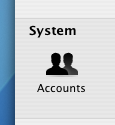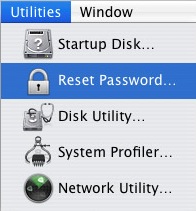Over the past few weeks, lots of people have been contacting Mac OS X Tips asking how to reset a forgotten Mac OS X user account password. Depending on the circumstances, this task could take 5 minutes or could even be completely impossible. Here is a run through of the different ways you can reset an account password depending on the type of account, whether FileVault is enabled and whether you have the Mac OS X Install Disc.
If you still know the Administrator Password
If you still know the password to an administrator account, it is very simple to reset any standard or managed user's password. While logged in as the administrator, open up System Preferences and click on the Accounts section. All the accounts on the computer should be listed down the left hand side. Under each account name it should say Admin, Standard or Managed. If the lock at the bottom of the window appears locked, click on it to allow changes to the preferences.
The next step is to select the user whose password you want to change and click on the Reset Password button. Enter the new password and click Reset Password. If you have created multiple Administrator accounts, you can use this method to reset their passwords too, as long as you know the password for the original administrator account.
Resetting an Administrator PasswordObviously, if you don't have access to an administrator account, you can't carry out any of the above steps. If you have forgotten the Administrator password or you can't log into your Mac at all, you will need to use the Mac OS X Install Disc.
Enter the Mac OS X Install Disc that is the closest version to that running on the Mac. For example, if you are running Mac OS X 10.4 Tiger, you should enter the Tiger install disk, not any earlier ones. Restart the computer, and hold the C key as it starts up. This might take longer than usual, and you can release the C key as soon as the Apple logo appears on the screen. When the window appears, choose your language and click the right arrow.
The next step depends on what version of Mac OS X you are using. For Tiger (10.4), choose Reset Password from the Utilities menu. For earlier versions, choose Reset Password from the Installer menu.
Choose your Hard Drive from the top and then choose the Account from the drop down menu. Be careful not to select System Administrator, as this is actually the root user, not the administrator account on your Mac. Now enter the new password, click Save, quit the Installer and restart the computer.
Note that there are a few issues with this method. Firstly, it does not reset your keychain password.
You will have to do this separately. Secondly, do not attempt this if you have FileVault enabled. To reset an FileVault protected account, you need the master password.
Resetting a FIleVault Protected User's Password
If you have enabled FileVault to encrypt your Account, you need to know the master password that you set when you enabled it. This is the password that the administrator should know that allows you to reset any password on the computer. If you have forgotten the master password, unfortunately your data is lost forever.
If you know the master password, start by attempting to log into your account. When you get the password wrong three times, you will be able to click "Forgot Password". Now you will have to enter the master password and then a new login password for your account.
If you have lost the Mac OS X install Disc
If you have lost the install disc, don't try and use one from an earlier version as this might permanently block you out of your account. You really have two options: Firstly, you could buy a new copy of Mac OS X (try
eBay). Secondly, there is a way of resetting an administrator password without the disc if you are running Mac OS X 10.4 Tiger.
Note: Do NOT do this with a FileVault protected account, or your data will be lost forever.First, note the short name of the account. This is the same as the name of its home folder, but not necessarily the name that appears in the login window. Restart your computer, and while it is starting up, hold Command-S. This will start up your Mac in Single User Mode. Once it has started up, you will need to enter three lines of code. Enter sh /etc/rc and press return. Then enter passwd yourusername and hit return. Now you will have to enter a new password twice. What you type won't appear on screen, but it is working. Once you have done this, type reboot and hit return.
This is the same as the Install Disc method in that it doesn't reset your Keychain password.
For That follow this


































 MacApp
MacApp